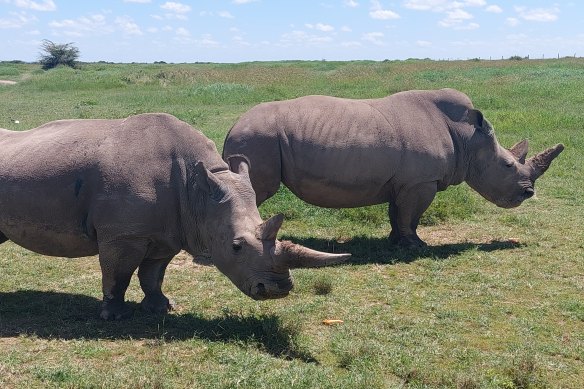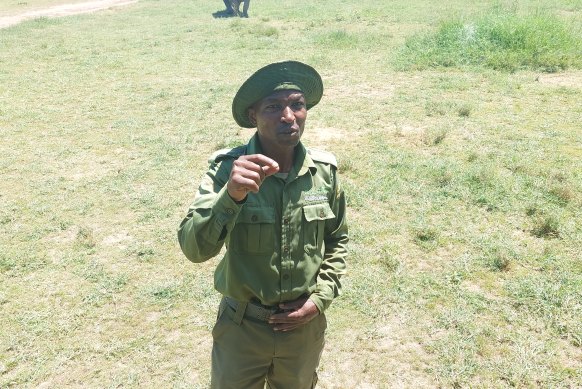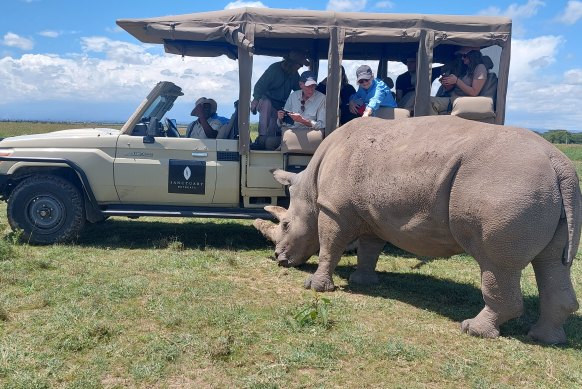Seeing the world’s loneliest animal moved me to tears. Now there’s hope
By Sue Williams
It’s hard not to be moved to tears by the sight of two lonely northern white rhinos standing under 24-hour armed guard in Central Kenya – the last of the species left in the world and, tragically, both female.
While civil wars in their natural rangelands and the despicable greed of poachers has all but driven them to extinction, incredibly, there’s now hope they might be saved by advances in a science lab almost 11,000 kilometres away in Germany.

And then there were two … Najin and Fatu.
“This could be amazing for future generations,” says their devoted carer Zacharia Mutai, 45, the head gatekeeper of white rhino in their 280-hectare wildlife area at the Ol Pejeta Conservancy, five hours north of Nairobi. “One day, we hope we’ll have more northern white rhinos. It will be a modern miracle.”
At the sound of his voice, Najin, 34, and her daughter, Fatu, 23, move closer. Mutai is a human they’ve come to trust and, as he offers them an armful of sugar cane, carrots and alfalfa, they’re coaxed to come closer to me, sitting inside a safari truck.
“You can stroke behind their ears,” Mutai instructs me, signalling me to lean out. “They like that. But stay inside the vehicle. They are still wild animals and their mood can change.”
Touching the leathery, two-centimetre-thick skin as they watch on, is spellbinding. And while the idea that these might be the last creatures of their kind still brings tears coursing down my face – for both them and the state of humanity that has allowed such a thing to happen – the prospect of a revival of the otherwise doomed species makes my heart skip a beat.
The miracle has been performed by scientists in the Leibnitz Institute for Zoo and Wildlife Research. Egg cells have been harvested cells from Fatu which have then been fertilised with frozen semen taken from one of the last male northern white rhinos. The result has been five embryos, with one about to be implanted into a hardier southern white rhino – which will be more capable of carrying the fetus for the punishing, 15-month pregnancy.

Najin and Fatu’s protector, Zacharia Mutai.
“This is the first time this has ever been tried,” says Mutai, whose father also devoted his life to the care of the white rhinos. “It’s never been done in rhinos before. But if this works … we could end up with many. It will be so amazing for the future generations.”
It could also prove to be the great white hope for the restoration of threatened species around the world.
I look over at Najin and Fatu, steadily chomping the food, unaware of the fuss they’re causing across the globe. The mother, weighing around two tonnes, is much bigger than her calf, but both are massive creatures. Rhinos are the second-largest land mammal on Earth.

Hopes are now high that IVF may help save the species.
At the 360- square-kilometre Ol Pejeta, a former working cattle ranch in colonial days which is now a trailblazer of conservation innovation in the foothills of Mount Kenya, and the largest black rhino sanctuary in East Africa, travellers are welcome to visit mother and daughter.
They’re also invited to donate to the rescue program or even to “adopt” a northern white rhino, while also going out on an exercise with the anti-poaching dog team set up to protect them.
It’s a magical meeting that adds real depth and meaning to any safari holiday. I stayed at travel company Abercrombie & Kent’s Sanctuary Tambarare in the conservancy, for instance, a beautiful lodge with only 10 glamping tents and a private villa hidden deep in nature on the pristine plains. It was the absolute highlight.
With about 52 southern white rhino and 165 critically endangered black rhino also in the conservancy, alongside chimpanzees and then elephant, giraffe, warthogs, lion, buffalo, zebra and every kind of antelope wandering through the savannah, it’s a wondrous kaleidoscope of life. And one, we hope, that can now be with us forever.
THE DETAILS
STAY
Sanctuary Tambarare at Ol Pejeta Conservancy in Kenya is from $US500 ($748) a person a night inclusive of all meals and drinks, or can be visited as part of a longer safari, for instance 11 days, also staying at the Namunyuk Wildlife Conservancy and the Masai Mara from $24,880 a person.
FLY
Emirates flies three-times daily from Sydney, and twice-daily from Melbourne, to Dubai and 25 times a week from Dubai to Nairobi, Kenya.
The writer was a guest of Abercrombie & Kent.
Sign up for the Traveller Deals newsletter
Get exclusive travel deals delivered straight to your inbox. Sign up now.